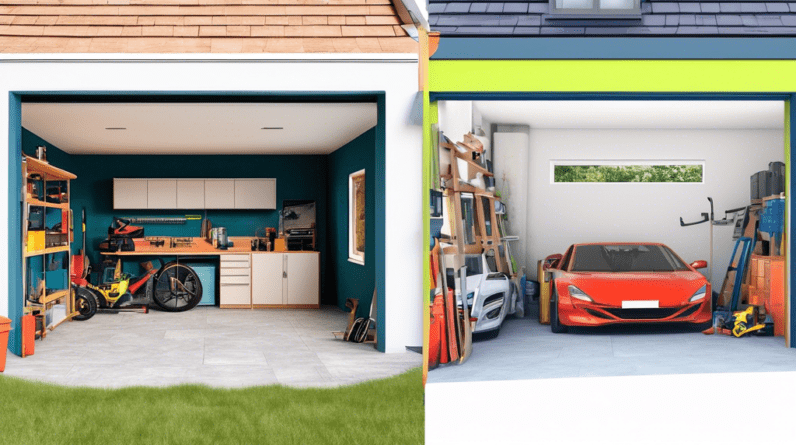
How to Achieve Garage Conversion Cost Savings
Plan Your Garage Conversion for Maximum Cost Savings
Embarking on a garage conversion is an exciting endeavor that can add significant value and functionality to your home. Whether you envision a cozy guest suite, a state-of-the-art home office, or a spacious playroom, careful planning is essential for maximizing cost savings without compromising on your vision.
Before diving into the construction phase, invest ample time in meticulous planning to identify potential cost-saving opportunities throughout the project. By addressing key considerations upfront, you can make informed decisions that align with your budget and prevent costly surprises down the road.
Set a Realistic Budget and Prioritize Spending
Establishing a realistic budget is paramount for any renovation project, especially when aiming for cost savings. Before contacting contractors, determine a comfortable budget range for your garage conversion, considering factors like your financial situation, the scope of the project, and local construction costs.
Once you have a clear understanding of your financial limits, prioritize spending based on the essential elements of your conversion. Allocate funds wisely, focusing on areas where quality matters most, such as foundation work, insulation, and structural modifications.
Remember that elaborate finishes and high-end fixtures can quickly inflate costs. Consider opting for cost-effective alternatives that still enhance the aesthetics and functionality of your space without breaking the bank.
Obtain Multiple Quotes and Negotiate with Contractors
Securing multiple quotes from reputable contractors is crucial for finding the best value for your investment. Reach out to at least three contractors in your area, providing them with detailed project specifications to ensure accurate estimates. When comparing quotes, focus not only on the overall price but also on the breakdown of costs for labor, materials, and permits.
Once you have received all the quotes, don’t hesitate to negotiate with the contractors to secure the most competitive price. While it’s essential to be respectful of their time and expertise, remember that they expect some level of negotiation. Be upfront about your budget constraints and explore potential areas for cost reduction.
DIY What You Can: Unleash Your Inner Handyperson
For homeowners with some construction experience and a DIY spirit, tackling certain aspects of the garage conversion yourself can lead to significant cost savings. Tasks such as demolition, painting, flooring installation, and trim work can often be handled by skilled individuals, reducing labor costs.
However, it’s crucial to assess your abilities realistically and only take on projects within your comfort zone. If you’re unsure about a particular task, it’s always best to consult with a qualified professional to avoid costly mistakes.
Get Creative with Recycled and Repurposed Materials
Incorporating recycled and repurposed materials into your garage conversion is an eco-friendly and budget-conscious choice. Salvage yards, online marketplaces, and even your local classifieds can be treasure troves of affordable building materials, fixtures, and furniture.
Consider using reclaimed wood for accent walls or shelving, sourcing vintage doors or windows for added character, or giving existing cabinets a fresh coat of paint for a modern touch. Not only will you save money, but you’ll also add unique charm and personality to your newly converted space.
Optimize Existing Structures and Utilities
Wherever possible, try to optimize the use of existing structures and utilities to minimize costs. For instance, if your garage already has a concrete floor in good condition, you may be able to avoid the expense of pouring a new one. Similarly, assess the feasibility of utilizing existing plumbing and electrical lines to reduce the need for extensive rerouting.
By strategically planning your conversion around these existing elements, you can streamline the construction process and potentially save thousands of dollars in unnecessary expenses.
Choose Energy-Efficient Solutions: Long-Term Savings
While energy-efficient appliances and fixtures may have a slightly higher upfront cost, they can lead to significant savings on your utility bills in the long run. Consider investing in energy-efficient windows, insulation, lighting, and appliances to reduce your home’s energy consumption.
These upgrades not only benefit your wallet but also contribute to a greener and more sustainable living environment. Explore available rebates and incentives for energy-efficient home improvements in your area to offset some of the initial costs.
Shop Smart: Compare Prices and Source Materials Wisely
Don’t settle for the first price you find! Take the time to shop around and compare prices from different suppliers for all your materials and fixtures. Building supply stores, online retailers, and discount outlets can offer competitive pricing, so it pays to do your research.
Consider purchasing materials in bulk, especially if you have ample storage space, as this can often lead to significant discounts. Negotiate prices with suppliers, especially for larger orders, and be on the lookout for sales and clearance events.
Plan for the Unexpected: Set Aside a Contingency Fund
Even with the most meticulous planning, unexpected issues can arise during any construction project. To avoid financial stress and potential delays, it’s crucial to set aside a contingency fund to cover unforeseen costs. A general rule of thumb is to allocate around 10-20% of your overall budget for contingencies.
This financial safety net will give you peace of mind knowing you have a buffer to handle unexpected repairs, material price increases, or changes in project scope. If you end up not needing to use the contingency fund, you can always allocate it towards other home improvement projects or savings.
Conclusion
A garage conversion can be a cost-effective way to add valuable living space to your home. By following the tips outlined above, you can achieve significant cost savings without sacrificing the quality or functionality of your conversion. Remember to plan carefully, prioritize your spending, explore DIY options, and shop smart to make the most of your budget.
With a little creativity, resourcefulness, and a willingness to put in some sweat equity, you can transform your underutilized garage into a beautiful and functional space that enhances your lifestyle and adds value to your property.






